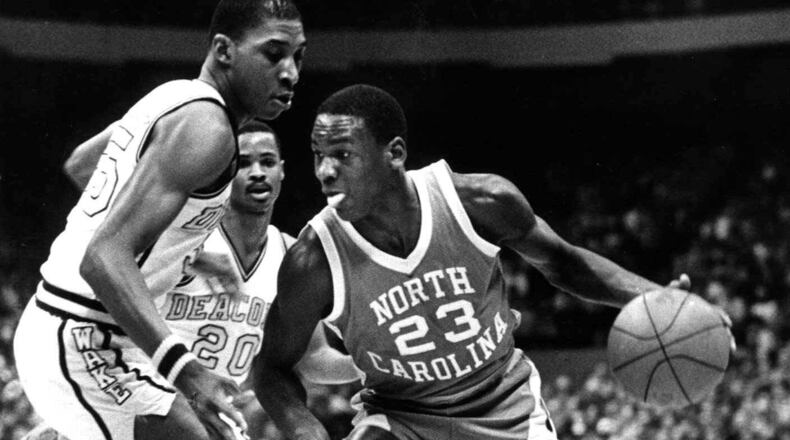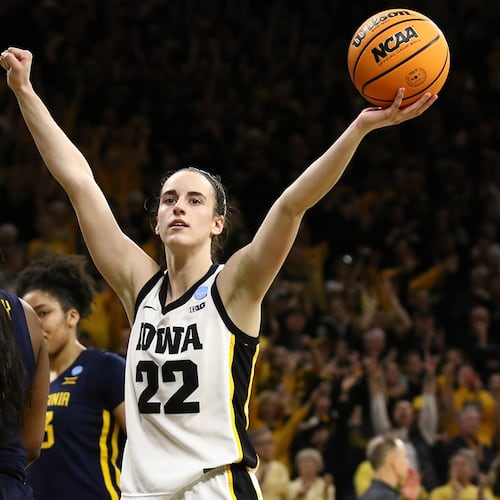There won’t be a Final Four this year — Atlanta’s loss after the NCAA Tournament was canceled due to the coronavirus pandemic. However, The Atlanta Journal-Constitution’s Mark Bradley, a 2015 inductee of the U.S. Basketball Writers Association Hall of Fame, will present his list of the Top 10 Final Fours of all-time. The list will be presented in reverse order, culminating with the greatest men’s basketball championship.
Today: No. 7 — 1982
This will be the first of two New Orleans Final Fours on our list. (Things are always a bit wilder in NOLA.) The 1982 installment was the first in the massive Superdome. It featured four head coaches who would make the Naismith Hall of Fame. It included Michael Jordan, Patrick Ewing, James Worthy, Clyde Drexler and Hakeem Olajuwon – five Hall of Fame players. It also included Louisville’s Doctors of Dunk. And, as an added treat, it introduced the world to something that would become known as Hoya Paranoia.
In his first Final Four, John Thompson headquartered his Georgetown team not in the French Quarter, not in the Warehouse District, not in Metairie or Kenner or Chalmette, not even in the great state of Louisiana. The Hoyas were billeted in Biloxi, Miss., which is closer to Mobile, Ala., than to the shiny dome on Poydras Street. The 6-foot-10 Thompson — he’d been Bill Russell’s backup with the Boston Celtics — wanted his student-athletes not to be led into the temptations lurking on Bourbon Street. They hunkered down 90 miles away.
“This is nothing new for me,” he told the assembled, which as you’d expect was going wild over the Biloxi bit. “You should have seen me when I was coaching high school basketball (at St. Anthony of Washington D.C.). I’d stay as far from games as the good sisters could afford.”
The other three qualifiers — North Carolina, Houston and Louisville — had plenty of Final Four history already. This was the nation’s first extended look at Thompson and Georgetown and especially the freshman Ewing. Thompson had sheltered his young center, allowing little media access. (And why did Ewing wear a T-shirt under his jersey?) The Hoyas were the mystery guest that was also downright mysterious. They darn near won the thing.
Carolina beat Houston in the first semifinal. Houston’s leading scorer that year wasn’t Drexler, who was a sophomore, or the redshirt freshman who wasn’t yet a starter and was then known as “Akeem Abdul Olajuwon.” It was guard Rob Williams, who had among the worst-ever Final Four games. He took eight shots. He made none. He had more turnovers (three) than points (two). The Tar Heels won 68-63 in a game seldom in doubt.
The second semifinal saw nobody shoot well. Between them, Georgetown and Louisville combined for 37 baskets against 36 turnovers over 40 minutes. The Hoyas defended with their usual fury, which the Cardinals came close to matching. Not close enough, though. Final score: Georgetown 50, Louisville 46.
This set up a final between Thompson and his good friend Dean Smith, who’d taken Carolina to six previous Final Fours without winning one. (The 1977 title game, which saw Smith revert to his infernal Four Corners just as the Heels were primed to blow out Marquette, was said to be the one game Smith’s associates never mentioned to him.) The decade of the ’80s was to feature a slew of epic finals. This was among the best.
Carolina’s first four baskets came courtesy of Ewing goaltends. Nonetheless, he’d established himself as an inside presence. Georgetown led by a point at the half. (By then, Ewing had five GTs.) The Heels nosed ahead in the second half, and near the end Smith trotted out the Four Corners, which worked until it stopped working. Eric Smith put the Hoyas ahead with 57 seconds to go. You know the rest.
Jimmy Black found Jordan, then a freshman, on the left wing. Nothing but net, 15 seconds left. The Hoyas hurried to answer. Fred Brown threw the ball straight to Worthy, who played for Carolina. (Hey, he WAS open. In trying to overplay a pass he thought was coming, he moved so quickly that Brown believed he was cutting to get the ball. Which he did.) Worthy missed two free throws, but no matter. Carolina won 63-62.
Smith had his long-sought championship, and the way it happened became a part of Jim Valvano’s stump speech. Then coaching N.C. State, Valvano claimed to have been sitting in the Superdome near some Carolina fans. He said he turned to them and asked, as Brown was moving upcourt, “What do you think?” One Heel backer said, “Dean’ll think of something.” Then Brown passed to the wrong team. The Heel backer poked Valvano on the shoulder. “Told you,” he said.
THE SERIES
No. 10: 1979
No. 9: 1991
No. 8: 1968
No. 7: 1982
–♦–
About the Author
The Latest
Featured



